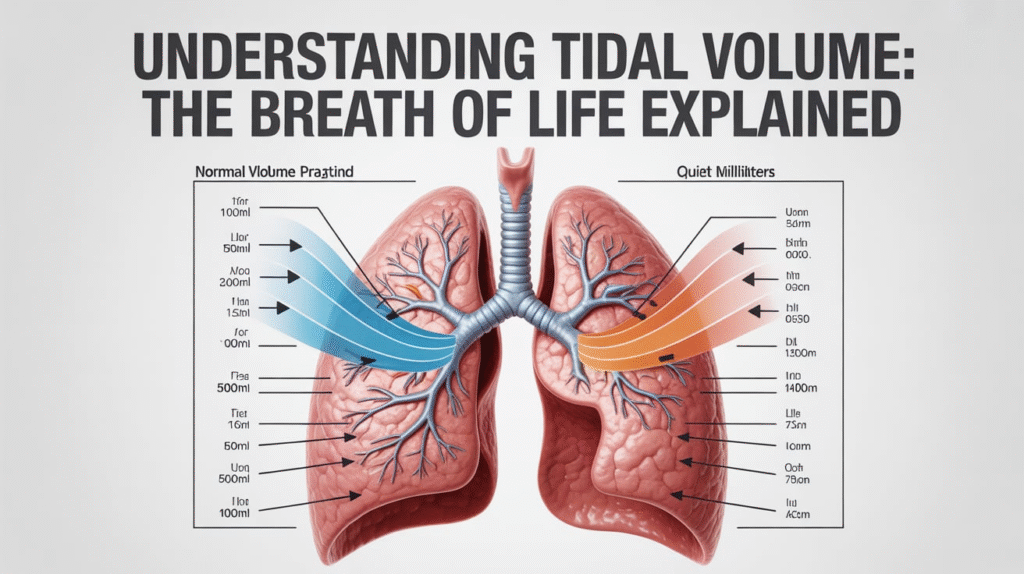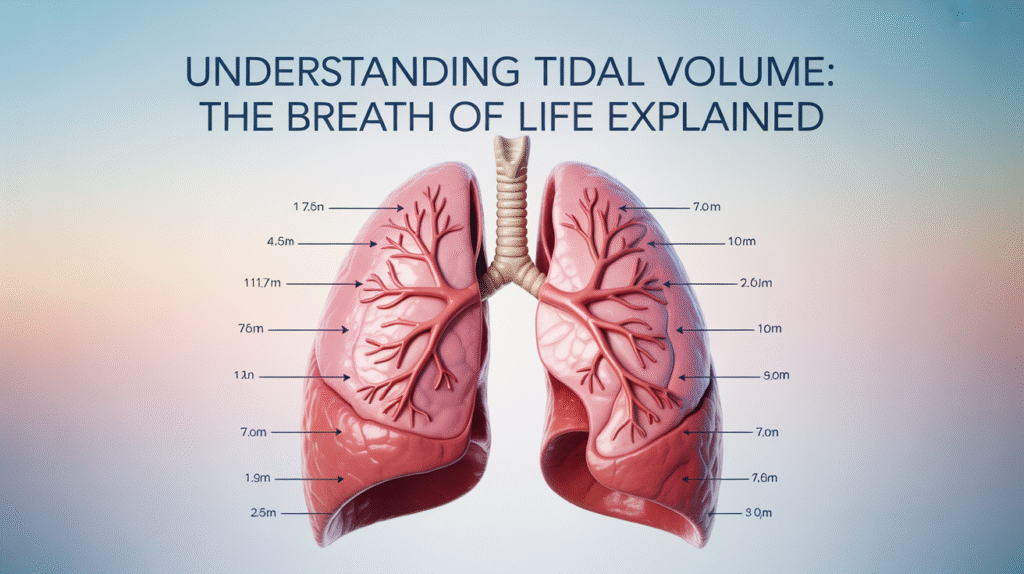Breathing is something we do without thinking. Every second, our lungs move air in and out to keep us alive. But have you ever wondered how much air you breathe in one normal breath? That amount of air has a special name — tidal volume. It’s a simple term with a big role in keeping your body healthy.
In this article, we’ll explore what tidal volume means, how it works, what affects it, and why it’s so important for your lungs and overall health. We’ll also look at how doctors measure it and how you can improve your breathing power naturally.
Table of Contents
What Is Tidal Volume?

Tidal volume is the amount of air you breathe in or out during a normal, relaxed breath. Imagine sitting quietly and breathing softly — that gentle breath in and out represents your tidal volume.
In adults, the average tidal volume is about 500 milliliters (ml) of air per breath — that’s about the size of a small water bottle. Of course, this amount can change depending on your size, age, health, and activity level.
When you exercise or feel stressed, your body needs more oxygen, so your tidal volume increases. When you rest or sleep, it decreases because your body needs less air.
Why Tidal Volume Matters
Your body depends on oxygen to make energy. Every cell needs oxygen to work properly. Tidal volume is how your lungs deliver that oxygen and remove carbon dioxide, the waste gas your body produces.
If your tidal volume is too low, you might not get enough oxygen. If it’s too high for a long time, it can strain your lungs. That’s why keeping a healthy, balanced breathing pattern is so important.
Doctors often check tidal volume in people with breathing problems, like asthma, COPD, or after surgery. It helps them see how well the lungs are working and how much air moves in and out with each breath.
How Tidal Volume Works Inside Your Body

When you breathe in, your diaphragm — a large muscle under your lungs — moves down. This creates space in your chest, and air flows into your lungs. When you breathe out, the diaphragm moves up, pushing the air out.
This simple process repeats every few seconds. Each normal breath moves your tidal volume of air through the lungs.
Inside your lungs are tiny air sacs called alveoli. This is where oxygen passes into your blood and carbon dioxide leaves it. The right tidal volume helps this gas exchange happen smoothly and efficiently.
Average Tidal Volume by Age and Size
Tidal volume can vary from person to person. A child has smaller lungs than an adult, so their tidal volume is smaller too.
Here’s a simple look:
- Adults: about 400–600 ml per breath
- Children: about 200–400 ml per breath
- Babies: around 50–100 ml per breath
People who are taller or have larger lungs often have a higher tidal volume. Meanwhile, athletes who train regularly may also have a bigger tidal volume because their lungs and breathing muscles are stronger.
Measuring Tidal Volume
Doctors use a device called a spirometer to measure tidal volume. It’s a simple test where you breathe into a tube connected to a machine that records your breathing pattern.
This test helps measure several things, like:
- Tidal Volume (TV): normal breath in or out
- Inspiratory Reserve Volume (IRV): extra air you can inhale after a normal breath
- Expiratory Reserve Volume (ERV): extra air you can exhale after a normal breath
- Residual Volume (RV): air left in your lungs after you breathe out fully
These measurements give doctors a full picture of your lung health.
Factors That Affect Tidal Volume
Many things can influence your tidal volume, including:
- Age: As we get older, our lungs lose some elasticity, which can reduce tidal volume.
- Fitness Level: People who exercise regularly often have a higher tidal volume because their lungs are more efficient.
- Posture: Sitting up straight helps your lungs expand better, while slouching can limit your tidal volume.
- Health Conditions: Illnesses like asthma, COPD, or pneumonia can affect how much air you breathe.
- Emotions: Stress or anxiety can make your breathing shallow and fast, reducing tidal volume.
Being aware of these factors can help you keep your lungs healthy.
Tidal Volume and Lung Capacity
Tidal volume is just one part of your total lung capacity. Your lungs can actually hold much more air than what you breathe in a normal breath.
Here’s a simple breakdown:
- Tidal Volume (TV): normal breath in and out
- Inspiratory Reserve Volume (IRV): extra air you can inhale
- Expiratory Reserve Volume (ERV): extra air you can exhale
- Residual Volume (RV): air left after full exhale
All these add up to your Total Lung Capacity (TLC). Understanding these helps doctors figure out how your lungs work as a system.
Tidal Volume During Exercise

When you exercise, your body needs more oxygen to fuel your muscles. To meet this demand, your breathing changes — you start breathing faster and deeper.
Your tidal volume can increase up to 2–3 liters per breath during intense exercise. That’s several times your normal amount!
This happens because your brain signals your diaphragm and breathing muscles to work harder. The deeper breaths help pull in more oxygen and remove more carbon dioxide, keeping your energy up.
That’s why athletes train their breathing — a stronger tidal volume means better performance and endurance.
Low Tidal Volume: Causes and Concerns
Sometimes, a person’s tidal volume may be lower than normal. This can happen for several reasons:
- Weak respiratory muscles
- Lung diseases like COPD or fibrosis
- Chest injuries or surgeries
- Obesity, which limits chest movement
- Shallow or anxious breathing
Low tidal volume can lead to less oxygen entering your blood and more carbon dioxide staying inside. This may cause fatigue, shortness of breath, or dizziness.
Doctors may recommend breathing exercises or medical devices to help improve it.
High Tidal Volume: When It Becomes Risky
While deep breathing is healthy, constantly breathing too deeply can also cause problems — especially if it’s forced or mechanical.
In hospitals, when patients are on mechanical ventilation, doctors carefully set the tidal volume on the machine. Too high a setting can overinflate the lungs and cause injury, while too low can cause oxygen shortage.
That’s why healthcare teams monitor tidal volume closely in critical care.
Improving Your Tidal Volume Naturally
The good news is that you can strengthen your lungs and improve your tidal volume naturally. Here are a few simple ways:
- Practice Deep Breathing: Sit or lie down, breathe slowly through your nose, and fill your lungs fully.
- Do Aerobic Exercise: Activities like swimming, walking, or biking strengthen your heart and lungs.
- Use a Breathing Trainer: Devices that add gentle resistance can make your lungs work harder and grow stronger.
- Maintain Good Posture: Straight posture opens your chest for better lung expansion.
- Avoid Smoking: Smoking damages lung tissue and reduces tidal volume over time.
Even just a few minutes of breathing exercises daily can make a big difference.
Tidal Volume in Medical Settings
In hospitals, tidal volume plays a critical role in ventilator management. When patients can’t breathe on their own, machines deliver a controlled amount of air each breath.
Doctors set this tidal volume carefully — usually around 6–8 ml per kilogram of body weight — to keep the lungs safe. This is part of a strategy called lung-protective ventilation, especially important in patients with conditions like ARDS (acute respiratory distress syndrome).
It shows how powerful and precise the concept of tidal volume is in saving lives.
The Connection Between Tidal Volume and Breathing Patterns
Your breathing pattern tells a story about your health. Shallow, fast breathing may mean stress, anxiety, or poor posture. Slow, deep breathing shows relaxation and strong lung function.
A healthy tidal volume helps maintain calm and balanced breathing. It keeps oxygen and carbon dioxide levels stable, which helps your brain, muscles, and heart work better.
That’s why practices like yoga and meditation focus on controlled breathing — they boost tidal volume naturally while calming your mind.
How to Check Your Own Breathing
You don’t need special equipment to get a feel for your tidal volume. Try this simple exercise:
- Sit comfortably and relax.
- Place one hand on your chest and the other on your belly.
- Take a slow breath in through your nose.
- Feel your belly rise more than your chest — that’s a good sign.
- Exhale slowly through your mouth.
This helps you become aware of your breathing depth and rhythm. Practicing mindful breathing can help increase your tidal volume over time.
The Role of Tidal Volume in Sleep
During sleep, your breathing slows down and becomes shallower. Your tidal volume naturally decreases because your body’s oxygen needs are lower.
However, some people experience breathing problems while sleeping — like sleep apnea, where breathing stops for short periods. This can lower oxygen levels and cause poor sleep quality.
Doctors sometimes measure tidal volume during sleep studies to understand these issues and guide treatment.
The Importance of Healthy Lungs
Your lungs are powerful organs that work nonstop to keep you alive. Keeping a good tidal volume is part of taking care of them.
Eat healthy foods, stay active, avoid pollution when possible, and don’t smoke. These habits protect your lung tissue and keep your breathing strong. Remember — every deep breath you take is a sign of life and energy.
FAQs
1. What is tidal volume in simple words?
Tidal volume is the amount of air you breathe in or out during one normal breath.
2. How much is normal tidal volume for an adult?
A normal adult tidal volume is about 500 ml, or half a liter, per breath.
3. Can you increase your tidal volume?
Yes! Deep breathing exercises, regular workouts, and good posture can help increase tidal volume naturally.
4. Why is tidal volume important in hospitals?
It helps doctors check lung function and set safe breathing levels for patients on ventilators.
5. What happens if tidal volume is too low?
Too low means less oxygen enters your blood, leading to tiredness, dizziness, or shortness of breath.
6. What’s the difference between tidal volume and lung capacity?
Tidal volume is just one normal breath. Lung capacity includes tidal volume plus all the extra air your lungs can hold.
Conclusion
Your tidal volume might seem like a small thing, but it’s a big part of how your body stays healthy. Every breath you take brings oxygen that fuels your life.
By understanding how tidal volume works — and how to care for your lungs — you can breathe more deeply, stay energized, and feel more alive every day.
So take a moment now. Sit up straight, close your eyes, and take a slow, deep breath. Feel your lungs fill with fresh air. That’s your tidal volume at work — simple, powerful, and essential.




